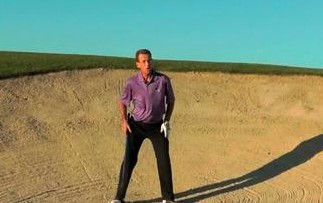Improve your bunker play video
Golf Monthly Top 25 coach Paul Foston has some tips to help you improve your bunker play and escape the sand successfully more often.


Golf Monthly Top 25 coach Paul Foston has some tips to help you improve your bunker play and escape the sand successfully more often.
When it comes to bunker play, one of the main problems I see is the way that the bounce of the club is, or isn’t, used.
The bounce is the angle that the sole is set at relative to the leading edge. Whether you have lots or little bounce on your wedges, the back edge will always sit lower than the leading edge.
When used correctly, this will ensure the club enters the sand in a way that gets the ball up quickly. A common mistake I see is players addressing the ball with their hands forward, causing forward shaft lean.
This lean towards the target decreases loft and bounce. From this position, the only thing that can make contact with the ball or sand is the leading edge, causing fats and thins.
Leaning the shaft away from the target will increase the loft and bounce, ensuring a nice shallow angle of attack that increases the margin for error.
Get the Golf Monthly Newsletter
Subscribe to the Golf Monthly newsletter to stay up to date with all the latest tour news, equipment news, reviews, head-to-heads and buyer’s guides from our team of experienced experts.
The set-up
Many amateurs approach the bunker shot as if it was a pitch shot, with a narrow stance and the shaft leaning towards the target.
For more consistency, assume a wide athletic stance and increase your knee flex. Lean the shaft away from the target to increase the loft and bounce.
The ball position should be forward of centre, with your hands positioned behind the ball. Resist the temptation to stand extremely open, as this will encourage you to dig into the sand. Stand slightly open to allow for a shallower angle of attack.
This simple tip at set-up should help you improve your bunker before you even start swinging the club.
Wrist break
With the greenside bunker shot, you cannot break your wrists early enough. Setting the wrists fully as you take the club away will highlight the need to create an angle in the wrists which can then be released fully through the shot.
This is effectively throwing the bounce at the sand and allowing it to do its intended job. As you follow through the clubhead will exit the sand faster than the ball.
Releasing the club
A great way to get a feel of what it’s like to release the club properly is to practise hitting shots one-handed.
Hitting bunker shots with your right hand (if you’re right-handed) will help prevent you from turning the club over, ensuring you maintain the loft as you make impact with the sand.
If you get the feeling of the clubhead leaving the sand in front of the ball, then you will have made an effective strike.
Study the sound
If you do everything mentioned here correctly, you should notice a very distinctive sound as your club enters the sand. I like to call it a puff rather than a thud.
With a shallow angle of attack that utilises the bounce of the wedge, the amount of sand you take should be minimal.
If you start taking lots of sand, pay particular attention to the set-up position, checking that the ball is forward in your stance and that the clubface and stance aren’t too open.

Tom Clarke joined Golf Monthly as a sub editor in 2009 being promoted to content editor in 2012 and then senior content editor in 2014, before becoming Sports Digital Editor for the Sport Vertical within Future in 2022. Tom currently looks after all the digital products that Golf Monthly produce including Strategy and Content Planning for the website and social media - Tom also assists the Cycling, Football, Rugby and Marine titles at Future. Tom plays off 16 and lists Augusta National (name drop), Old Head and Le Touessrok as the favourite courses he has played. Tom is an avid viewer of all golf content with a particularly in depth knowledge of the pro tour.
-
 Volvo China Open 2025 Picks, Odds And Predictions
Volvo China Open 2025 Picks, Odds And PredictionsFollowing a break for The Masters, the DP World Tour returns for the final two weeks of its Asian Swing and the Volvo China Open is the penultimate event
By Jonny Leighfield
-
 Rory McIlroy's Sports Psychologist Explains Why He 'Didn't Talk' To Bryson DeChambeau In Masters Final Round
Rory McIlroy's Sports Psychologist Explains Why He 'Didn't Talk' To Bryson DeChambeau In Masters Final RoundDeChambeau raised eyebrows at Augusta National when claiming that McIlroy wouldn't engage in conversation during the final round of The Masters
By Jonny Leighfield